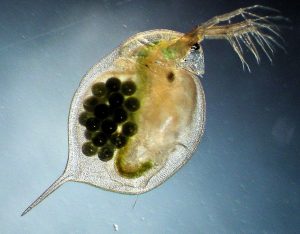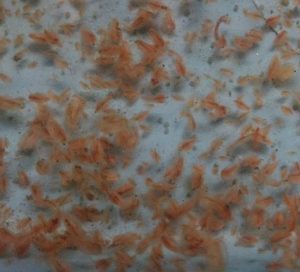Daphnia (Daphnia Magna) are known to tropical fish keeping enthusiasts as Water Bugs or Water Fleas and make an excellent live freshwater food source that can be collected from farm ponds, acidic swamps, or easily cultured in your home.
Daphnia Magna are small plankton like crustaceans that are found in South America and throughout the northern hemisphere in shallow, sediment laden lakes and ponds that are rich in organic matter.
Daphnia Magna can tolerate levels of salinity up to 20% and are found in both fresh and brackish water ephemeral rock pools near the ocean, large and small lakes, and farm ponds.
Although Daphnia Magna are small (.08 – .20 inch), they are larger than the more common Daphnia pulex which range in size from 0.01–0.20 inch.
Daphnia Magna are have a chitin carapace, five pairs of thoracic legs that are used to filter unicellular algae, bacteria, and detritus, a hook shaped intestine with two digestive cavities, and a ventral opening. They have a relatively large compound eyes, two antennae on their head, and rows of small spikes along the back of the carapace.
Females have two distinct combs on their abdomen and are larger than males. Although males are smaller than females, their first antenna is always larger than those of the females.
Daphnia Magna are are high in protein (up to 70%), extremely easy to cultivate, will not degrade the water quality in your aquariums, and will stay alive in the tank until your fish are ready to eat them; however, because eating too many Daphnia acts as laxative to your fish, they should not be exclusively used as a live food source.
One simple method of cultivating Daphnia Magna indoors is described below:
- Use a growing tank
(or a bucket) of whatever size you are comfortable with and fill it with aged aquarium water collected from a fresh water change. This provides an immediate food source for the Daphnia.
- You can add natural rock gravel
on the bottom of the tank along with a piece of driftwood
and even plants if desired, along with some pond snails, rams horn snails, or corkscrew snails to clean up excess waste.
- Add an air stone that will provide large bubbles for aeration and keep the pH of the water in the 6 to 8 range, preferably more alkaline than acidic.
- Water temperature is not a critical factor, but is best kept in the 62 to 75 degree F range for optimal growth. Daphnia Magna are so tolerant of temperature changes that they can be frozen and later “revived” for feeding as needed.
- If you are hatching out eggs, provide a light source above the culture tank and within 48 to 72 hours you will have a batch of newly hatched Daphnia Magna.
After hatching, a light source of at least 850 lumens should be kept over the growing tank for 8 to 12 hours daily. A cheap timer can maintain this when raising Daphnia indoors. - Feeding Daphnia Magna is where most tropical fish keeping enthusiasts fall short.Daphnia Magna feed on dissolved organic matter. Although microalgae, detritus, mulm, various kinds of bacteria, yeast, spirulina, organic fertilizers, and even fresh cow manure can be fed to your Daphnia, a much better option is a mixture of 1 tsp. each of spirulina
, soy flour
, and an active dry yeast into a pint of aquarium water. When mixed correctly, the water should be very cloudy.
- Place the Daphnia culture into the growing tank and slowly add the liquid “food” mixture to the tank until the water turns cloudy. You should still be able to clearly see the bottom of the tank as well as the Daphnia swimming around in the culture. Feed the Daphnia Magna regularly every 2 to 3 days, but do not overfeed.
Daphnia reproduce quickly and in a few weeks you should have enough to provide an ongoing live food source for your tropical fish.
Harvest them with a small aquarium net.
Adult daphnia are easily collected in the net. The smaller Daphnia will fall through the mesh and continue to reproduce in the culture to produce more live food for your tanks.
An easy method of cultivating Daphnia Magna outdoors is described here:
- One of the best containers you can buy for raising daphnia outdoors is a plastic children’s wading pool about 4 feet in diameter. It is inexpensive, will last for years, and provides plenty of surface area that the daphnia require.
- Situate one growing container in sunlight and another in partial sunlight and fill it them with water. More sunlight will better promote the growth of green algae that the Daphnia feed on, but because Daphnia have growing cycles where you will have a bloom with more than you can use, followed by a crash with only a few in the pool; a second or even a third culture is good insurance.
- Add some green water or water from your tank’s water change, and a little soluble plant fertilizer to each of the pools. In a week or so you should have a green algae bloom in the containers.
- When the water turns green, add the Daphnia Magna starter culture, and in another 2 or 3 weeks you should have plenty of adult Daphnia to feed your fish .
Establishing a colony of Daphnia Magna will provide an excellent high protein live food source for your tropical fish. Many tropical fish keeping enthusiasts who are breeders of difficult species keep several colonies going in case one colony crashes.
Live Daphnia and dry Daphnia eggs
are available for culture online from a variety of suppliers along with commercially mixed food, growing instructions, etc.




2 Responses to “Daphnia (Daphnia Magna)”
Trackbacks/Pingbacks
[…] brood pouch of Moina is open, whereas Daphnia posses a completely closed […]
[…] pulex are smaller (.008 to .12 inch in length) versions of Daphnia magna, a larger cousin to Moina macrocopa, and the small cousin to Simocephalus […]